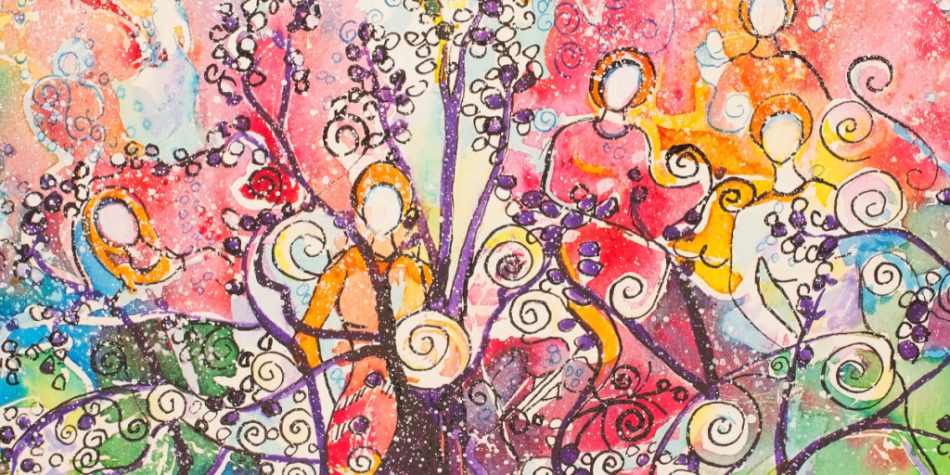The “Certain Women” art exhibit, sponsored by the non-profit Zion Arts Society and located at Anthony’s Antiques in Salt Lake City, is a stunning show. Over a hundred works are featured, all by Latter-day Saint women seeking to impart to the viewer a vision of the female gaze as it contemplates Latter-day Saint teachings about our Heavenly Parents—a father in heaven, and a mother.
Each work is accompanied by a statement from the artist explaining the origin and meaning of the piece. The belief in a Mother in Heaven is special to The Church of Jesus Christ of Latter-day Saints among the Christianities of the world. While some Christian faiths view Mary, the mother of Jesus, as a semi-divine being, Latter-day Saints teach both reverence for Mary as the mother of Christ and that our Heavenly Father is not alone single man, but instead is eternally married to a divine woman, a goddess.
Eve, then, was made in the divine image of a Mother in Heaven, and the destiny of Eve and all of her daughters is to follow the same path of wisdom from female life experiences toward a divine destiny made possible through Jesus Christ’ atonement and gospel.
And yet, beyond a long list of Church pronouncements, there are fewer revealed teachings regarding our Mother in Heaven. These artists are reaching out with their own female sensibilities to honor their Heavenly Parents through their artistic craft. A daughter’s view of her Mother cannot help but come from a very special perspective. There is an identification and a sense of recognition that permits a deeper understanding. And the media in the show are diverse—ceramics, rock carving, fabric art, furniture, paintings, photography, and more—representing the idea that each daughter approaches her mother in a unique way. The belief in a Mother in Heaven is special to Latter-day Saints.
Have you ever wondered what the famous Sistine Chapel painting of fingers touching would have looked like from the female gaze? It is here, by Shelley Detton, in her piece “In Her Image.” Have you ever imagined how near Heavenly Mother was as Mary mothered Jesus? It is here, by Jolynn Forman, in a work entitled, “A Mother’s Blessing Upon One Who Will Raise Her Son.” Are you convinced She is actively involved in our lives, though we do not see Her (Emily Carruth Fuller, “Heavenly Mother Watching Over Her Children)? Do you feel we have not fully understood why there were two trees and two persons in the Garden of Eden? Let the visions of Heather Graham (“The Great Plan of Salvation”) and Nancy Andruk Olson (“Every Which Way”) offer their artistic expressions.
There are many pieces I would wish to tell you about, but two are worth singling out. The first is the majestic round painting by Rose Datoc Dall, entitled “The Veil Over the Earth is Beginning to Burst.” In her one-of-a-kind style, Dall shows us our Heavenly Mother and Heavenly Father, regal and loving, looking down through a diaphanous veil, which is parting to reveal them fully to Their children. Dall’s precision has them looking directly down at the viewer who is looking up at them, and the effect is electric. The Two are there, the two yearn for us to know Them.
Another piece that struck me right in the heart was a mosaic-like piece by Rebecca Klundt entitled “Hannah’s Gift.” We all know the story of barren Hannah, who promised her first-born son to the Lord, and who had to then give the boy away to strangers when he was between the ages of 3 and 5. What an immense sacrifice. And yet the scriptures briefly note that she visited her son in the temple each year and brought a new little coat for him each time. Depicted is one of those little coats, which her hands must have made with both intense love and intense yearning, missing her boy so much, and yet offering him without complaint. That one tiny scripture is given its rightful, glorious due by the artist, and we see what we have never seen before.
The name of the show comes from Luke 8:2, which speaks of how “certain” women followed the Lord in His preachings along with the twelve apostles. Surely these artists of the “Certain Women” show are just such disciples. The show is open daily until 13 November. My recommendation is that if you live within a six-hour driving radius of downtown Salt Lake, go see the show. If that is difficult or impossible, once again, check out the images online here.

















